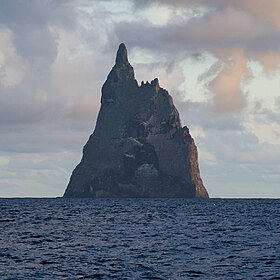Balls Pyramid
| Ball's Pyramid | |
|---|---|

Ball's Pyramid from the north
|
|
| Highest point | |
| Elevation | 562 m (1,844 ft) |
| Coordinates | 31°45′15″S 159°15′06″E / 31.75417°S 159.25167°ECoordinates: 31°45′15″S 159°15′06″E / 31.75417°S 159.25167°E |
| Geography | |
|
Location on a map of Oceania
|
|
| Location | Australia |
| Parent range | Lord Howe Island Group |
| Geology | |
| Age of rock | less than 7 million years |
| Mountain type | Volcanic plug |
| Volcanic arc/belt | Lord Howe seamount chain |
| Last eruption | Unknown |
| Climbing | |
| First ascent | 1965 |
Ball's Pyramid is an erosional remnant of a shield volcano and caldera that formed about 6.4 million years ago. It lies 20 kilometres (12 mi) southeast of Lord Howe Island in the Pacific Ocean. It is 562 metres (1,844 ft) high, while measuring only 1,100 metres (3,600 ft) in length and 300 metres (980 ft) across, making it the tallest volcanic stack in the world. Ball's Pyramid is part of the Lord Howe Island Marine Park in Australia.
The pyramid is named after Lieutenant Henry Lidgbird Ball, who reported discovering it in 1788. On the same voyage, Ball also reported discovering Lord Howe Island.
In The Voyage Of Governor Phillip To Botany Bay With An Account Of The Establishment Of The Colonies Of Port Jackson And Norfolk Island (1789), Arthur Phillip gives this description of the area around Ball's Pyramid, before describing Lord Howe Island:
There lies about four miles from the south-west part of the pyramid, a dangerous rock, which shows itself a little above the surface of the water, and appears not to be larger than a boat. Lieutenant Ball had no opportunity of examining whether there is a safe passage between them or not.
The first person to go ashore is believed to have been Henry Wilkinson, a geologist at the New South Wales Department of Mines, in 1882.
In 1964 a Sydney team, which included adventurer Dick Smith and other members of the Scouting movement, attempted to climb to the summit of the pyramid; however, they were forced to turn back on the fifth day as they ran short of food and water.
The first successful climb to the summit was made on 14 February 1965 by a team of climbers from the Sydney Rock Climbing Club, consisting of Bryden Allen, John Davis, Jack Pettigrew and David Witham.
In 1979, Smith returned to the pyramid, together with climbers John Worrall and Hugh Ward. They successfully reached the summit and unfurled a flag of New South Wales provided to them by Premier Neville Wran, declaring the island Australian territory (a formality which it seems had not previously been done).
...
Wikipedia

